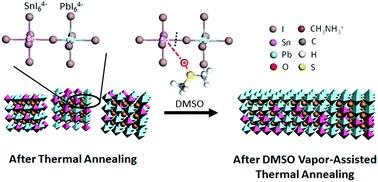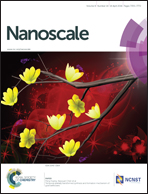Solvent-molecule-mediated manipulation of crystalline grains for efficient planar binary lead and tin triiodide perovskite solar cells†
Abstract
Binary lead and tin perovskites offer the benefits of narrower band gaps for broader adsorption of solar spectrum and better charge transport for higher photocurrent density. Here, we report the growth of large, smooth crystalline grains of bianry lead and tin triiodide perovskite films via a two-step solution process with thermal plus solvent vapor-assisted thermal annealing. The crystalline SnxPb1−xI2 films formed in the first step served as the templates for the formation of crystalline CH3NH3SnxPb1−xI3 films during the second step interdiffusion of methylammonium iodide (MAI). Followed by dimethylsulfoxide (DMSO) vapor-assisted thermal annealing, small, faceted perovskite grains grew into large, smooth grains via the possible mechanism involving bond breaking and reforming mediated by DMSO solvent molecules. The absorption onset was extended to 950 and 1010 nm for the CH3NH3SnxPb1−xI3 perovskites with x = 0.1 and 0.25, respectively. The highest PCE of 10.25% was achieved from the planar perovskite solar cell with the CH3NH3Sn0.1Pb0.9I3 layer prepared via the thermal plus DMSO vapor-assisted thermal annealing. This research provides a way to control and manipulate film morphology, grain size, and especially the distribution of metal cations in binary metal perovskite layers, which opens an avenue to grow perovskite materials with desired properties to enhance device performance.


 Please wait while we load your content...
Please wait while we load your content...